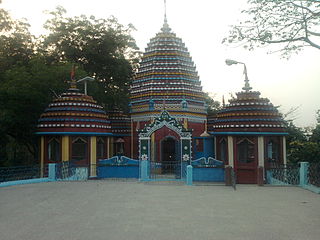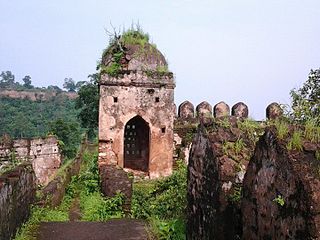Related Research Articles

Palamu district is one of the twenty-four districts of Jharkhand, India. It was formed in 1892. The administrative headquarters of the district is Medininagar, situated on the Koel River. Palamu district lies in north-western part of Jharkhand. It shares border with Chatra, Garhwa & Latehar Districts of Jharkhand state and Aurangabad, Gaya & Rohtas Districts of Bihar state.
Ramgarh Raj was the major Zamindari estate in the era of the British Raj in the former Indian province of Bihar. Territories which comprised the Ramgarh Raj presently constitute districts of Ramgarh, Hazaribagh, Chatra, Giridih, Koderma, and Bokaro with 3672 villages. The entire area is rich in minerals like coal and mica and falls under the Indian State of Jharkhand. The First King was Maharaja Baghdeo Singh and the last ruling king was Maharaja Kamakhya Narain Singh of this estate, until the estate was merged to the Republic of India. The revenue of the estate was about 3600000.

Ramgarh Cantonment, usually referred to as Ramgarh Cantt or just Ramgarh is a cantonment town, belonging to the Ramgarh district of the Indian state of Jharkhand. Historically, a subdivision of the larger Hazaribag district, Ramgarh was finally elevated to a district status on 12 September 2007 largely to ease administrative hardships.
The region have been inhabited since the Stone Age. Copper tools from the Chalcolithic period have been discovered. This area entered the Iron Age during the mid-2nd millennium BCE.

Ramgarh district is one of the 24 districts in the Indian state of Jharkhand. It was also a military district during the British Regime, referred to then as Ramgarh district. It is the part of State Capital Region (SCR).

The Palamu kila are two ruined forts located 3 k.m from Betla National Park, Latehar district on the bank of Auranga River, in the Indian state of Jharkhand. The old fort in the plains, which existed even before the Chero dynasty, was built by the King of Raksel dynasty. The original fort in the plains and the other on an adjoining hill are attributed to the kings of the Chero dynasty. The fort in the plains had defences on three sides and three main gates. The New fort was constructed by Raja Medini Ray. East India company used this fort to prison Narayan Peshwa of Tiroha and Raja Harsh dubey alias Subedar Aftab Singh mutineers of 1857.

Ramgarh Tal is a lake located in Gorakhpur, Uttar Pradesh, India. In 1970, at its largest size, the lake covered an area of 723 hectares with a circumference of 18 kilometres (11 mi). Today, it covers about 678 hectares.
Tourism in Jharkhand refers to tourism in the Indian state of Jharkhand. Jharkhand is known for its waterfalls, hills and holy places.
Medini Raia.k.a.Madini Rai or Madini Rao ruled from 1658 to 1674 in the Palamu region of Bengal, now in Jharkhand.

The Nagvanshis of Chotanagpur, also known as the Khokhra chieftaincy, was an Indian dynasty which ruled the parts of Chota Nagpur plateau region during the medieval and modern periods. Phani Mukut Rai, considered the first king of the dynasty, claimed to be the son of Pundrika Naga, a mythical Naga. Lal Chintamani Sharan Nath Shahdeo (1931–2014) was last ruling king of the dynasty, until the estate was merged to the Republic of India.
The Nagpuria people, also Nagpuri or Sadan, are an Indo-Aryan speaking ethnolinguistic group who are the native speakers of the Nagpuri language and natives of the western Chota Nagpur Plateau region of Indian states of Jharkhand, Bihar, Chhattisgarh and Odisha.
Sadan are the native Indo-Aryan-speaking ethnolinguistic groups of Chota Nagpur Plateau consist of Indian state of Jharkhand and neighbouring states who speak Nagpuri, Khortha and Kurmali language as their native language.
The Chero dynasty or Chyavana dynasty was a polity that ruled the northern regions of the Indian subcontinent, corresponding to the present-day Indian states of Bihar, Uttar Pradesh, and Jharkhand, after the fall of the Pala Empire; their rule lasted from the 16th century CE to the starting of the 19th century.

Raghunath Shah was a Nagvanshi king in the 17th century. He succeeded his father Ram Shah in 1663. His capital was at Navratangarh. He built several temples during his reign.

Mahadev Temple is a Hindu temple, dedicated to Lord Shiva, located in Deobaloda in the Indian state of Chhattisgarh. This temple belongs to the Kalchuri Period. The temple is a protected monument under the Archaeological Survey of India. The temple witnesses high footfall during Mahashivratri when the devotees from nearby villages gather here for Lord Shiva’s blessing. The event is also accompanied by a small fair.
Yadunath Shah was a Nagvanshi king in the 18th century. His capital was at Navratangarh. He succeeded Raghunath Shah and ruled from 1690 to 1724 CE. He shifted his capital from Navratangarh to Palkot.
Dripnath Shah was a Nagvanshi king in the 18th century. His capital was at Palkot. He succeeded Maninath Shah and ruled from 1762 to 1790 CE. He became a vassal of the East India Company in 1771. He submitted list of Nagvanshi kings to Governor general of India in 1787.
Mukund Singh was king of Ramgarh in the 18th century. He succeeded Bishan Singh. He ruled from 1763 to 1772 CE. He had made alliance with Maratha against East India Company. He defeated forces of claimant king of Ramgarh, Tej Singh Thakurai, Nagvanshis and Palamu. But In 1772, he accepted suzerainty of the East India Company as he didn't get support of Maratha in battle against East India Company. Then he disposabed from throne and Tej Singh Thakurai became new king of Ramgarh.
Nagpuri literature refers to literature in the Nagpuri language, the language of Jharkhand, Chhattisgarh and Odisha. The earliest literature started in the nagpuri language when the Nagvanshi king and king of Ramgarh Raj started writing poetry in the 17th century. Since then, various literature has been written. Although in the present century, Nagpuri was never considered worthy of literary development. But some dedicated writers have engaged in writing short stories, plays and poetry.
References
- ↑ "रामगढ़ कैथा प्राचीन शिव मंदिर में आस्था की अद्भुत मान्यता, यहां चढ़ाए जल से ठीक हो जाते हैं बहते कान!". news18. 4 November 2021. Retrieved 10 August 2022.
- ↑ "रामगढ़ का कैथा शिव मंदिर राष्ट्रीय धरोहर घोषित". livehindustan. 20 September 2016. Retrieved 10 August 2022.
- ↑ "Giant new chapter for Nagpuri poetry". telegraphindia. 5 November 2012.
- ↑ Jharkhand Encyclopedia Hulgulanon Ki Partidhwaniyan-1.